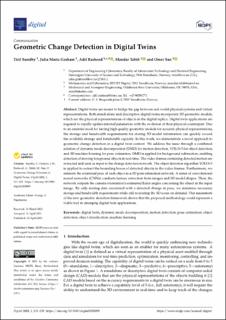| dc.contributor.author | Sundby, Tiril | |
| dc.contributor.author | Graham, Julia Maria | |
| dc.contributor.author | Rasheed, Adil | |
| dc.contributor.author | Tabib, Mandar | |
| dc.contributor.author | San, Omer | |
| dc.date.accessioned | 2021-04-16T12:13:01Z | |
| dc.date.available | 2021-04-16T12:13:01Z | |
| dc.date.created | 2021-03-16T22:32:17Z | |
| dc.date.issued | 2021 | |
| dc.identifier.citation | Digital. 2021, 1 111-129. | en_US |
| dc.identifier.uri | https://hdl.handle.net/11250/2738154 | |
| dc.description.abstract | Digital twins are meant to bridge the gap between real-world physical systems and virtual representations. Both stand-alone and descriptive digital twins incorporate 3D geometric models, which are the physical representations of objects in the digital replica. Digital twin applications are required to rapidly update internal parameters with the evolution of their physical counterpart. Due to an essential need for having high-quality geometric models for accurate physical representations, the storage and bandwidth requirements for storing 3D model information can quickly exceed the available storage and bandwidth capacity. In this work, we demonstrate a novel approach to geometric change detection in a digital twin context. We address the issue through a combined solution of dynamic mode decomposition (DMD) for motion detection, YOLOv5 for object detection, and 3D machine learning for pose estimation. DMD is applied for background subtraction, enabling detection of moving foreground objects in real-time. The video frames containing detected motion are extracted and used as input to the change detection network. The object detection algorithm YOLOv5 is applied to extract the bounding boxes of detected objects in the video frames. Furthermore, we estimate the rotational pose of each object in a 3D pose estimation network. A series of convolutional neural networks (CNNs) conducts feature extraction from images and 3D model shapes. Then, the network outputs the camera orientation’s estimated Euler angles concerning the object in the input image. By only storing data associated with a detected change in pose, we minimize necessary storage and bandwidth requirements while still recreating the 3D scene on demand. Our assessment of the new geometric detection framework shows that the proposed methodology could represent a viable tool in emerging digital twin applications. | en_US |
| dc.language.iso | eng | en_US |
| dc.publisher | MDPI | en_US |
| dc.rights | Navngivelse 4.0 Internasjonal | * |
| dc.rights.uri | http://creativecommons.org/licenses/by/4.0/deed.no | * |
| dc.title | Geometric Change Detection in Digital Twins using 3D Machine Learning | en_US |
| dc.type | Peer reviewed | en_US |
| dc.type | Journal article | en_US |
| dc.description.version | publishedVersion | en_US |
| dc.source.pagenumber | 111-129 | en_US |
| dc.source.volume | 1 | en_US |
| dc.source.journal | Digital | en_US |
| dc.identifier.doi | 10.3390/digital1020009 | |
| dc.identifier.doi | https://doi.org/10.3390/digital1020009 | |
| dc.identifier.cristin | 1898508 | |
| cristin.ispublished | true | |
| cristin.fulltext | original | |

